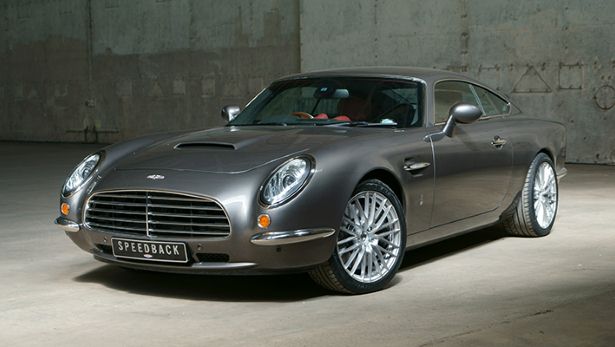
David Brown wouldn't claim to be a visionary, but he does claim to be a man who enjoys life. He recently invested in a splendid micro-brewery called Bad Co., and amongst many other things once owned an award-winning Yorkshire department store.
What you make of his car, the David Brown Speedback, depends on how much you buy into the bloke. To a certain extent this is true of all low volume carmakers, but David isn't a shadowy investor figure.
He's the man who had the plan and reckons there might be enough people out there who like the same things he does. In a nutshell, a swoopy looking GT that references a bunch of 1960s classics without falling into cartoonish cliché, and embraces the idea that to travel hopefully is a better thing than to arrive. Preferably in a car that looks cool and doesn't break down.
"I did an historic rally in a Ferrari Daytona a while back," he says, "which is a beautiful car, no question. But it kept overheating, and finally gave up the ghost. I was delighted, because it meant I could get into a Peugeot hire car that had air conditioning. I love the Sixties coachbuilding tradition, and most of the great cars from that period were done by the same bunch of guys out of workshops on the same few streets in Modena. I also love the idea of a proper long distance gran turismo. I'm not interested in doing 322km/h."
The Speedback fits into the currently thriving ‘resto-mod' scene, but Brown is no dilettante. In fact, he's steeped in good old-fashioned British engineering.
The family business was in manufacturing, dumper trucks and vast earth-moving equipment to be exact, before industry titan Caterpillar came along in the late Nineties and made him an offer he couldn't refuse. So when work started on the Speedback, barely 18 months ago, Brown not only knew what he wanted, he knew how to get it, too.
The donor car is a Jaguar XK convertible, which is stripped back to reveal its lightweight aluminum monocoque. Working with the Premier Group in Coventry - who made the torches for the Olympics and fabricated the body on the Queen's ceremonial Bentley - the Speedback's body panels are hand-beaten over a traditional forming buck.
This echoes the techniques used by the Italian artisans Brown reveres, although those guys didn't have five-axis milling machines or digital modelling software, and often ended up making doors that were an inch longer on one side than the other.
No such wayward tolerances here. Once they're done, the panels are attached to the structure's hard-points, and forensically inspected. Then the body is painted, in a triple-layer process that takes 120 hours. If you're laying out half a million big ones, you may as well do it right.
Brown has invited TG.com to the Yorkshire Dales to drive the Speedback, on roads only recently vacated by the Tour de France peleton, and still basking in unusually warm sun.
That same light would mercilessly expose any flaws in the Speedback's finish, but it really is extremely impressive. The shutlines are tight, there are no gluey splashes on the window seals, and the paint and brightwork are lustrous.
It also looks a lot better in the flesh than in images, and less like the Aston Martin DB5 pastiche I had it pinned as. The Speedback was designed by former Land Rover man, Alan Mobberley, and gets progressively more intriguing the further your eye travels along it.
It's low, wide and has enormous presence, and its body sides are free of the lines, creases and other tricks that car designers use to take weight out of a porky shape. What jewellery there is is also nicely judged - the clasps cradling the LED lights ape the bezel on an expensive watch, the enamel badges are lovely, and the nickel-plated side strakes look cool. An intrusive suspension upright has necessitated that awkward split in the rear windows.
The interior architecture is largely XK, but milled aluminium switchgear replaces the plastic items on the donor car. There's saddle leather all over the place, elm wood on the dash and doors, and Alcantara roof headlining.
The wood-rimmed wheel looks iffy but feels great, and Brown admits that the bespoke dials in the instrument panel need a bit of finessing. Which is a polite way of saying that they're tricky to read. As with the exterior, though, the cabin is immaculately finished.
Given its underpinnings, and the fact that there's a 507bhp 5.0-litre supercharged Jaguar V8 upfront, the Speedback feels like an XKR on the move. No bad thing, of course, and there's a reassuringly familiar sense of languid high performance. More surprising, perhaps, is the car's terrific rigidity and refinement. You might expect some glitches on the window sealing, for example, but the only problem I could detect was slightly squeaky leather.
Although some of the roads up here were resurfaced for the Tour, there are still enough blind crests and undulations to give the Speedback's dynamics a decent workout, and it blends fine body control with impressive compliance. In fact, because it's wearing unfashionably tall tyres, the ride is even better than the regular XK's.
No doubt that comes at the expense of ultimate handling poise, but I can't be sure: I had the man beside me, and dry stone walls and sheep to contend with.
Brown says that he has six orders in the bank already, and with each car taking six months to manufacture that's enough to be getting on with. The Speedback costs SGD$1.2 million in the UK, which is a chunk of cash to shell out on a rebodied Jaguar whichever way you slice it.
But this is a hugely charismatic car, backed by an equally charismatic individual of the sort we could do with more of in the car world. Raise a glass of real ale to him, and wish him the best of British luck.
